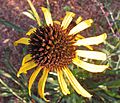Yellow coneflower facts for kids
Quick facts for kids Yellow coneflower |
|
|---|---|
 |
|
| Scientific classification | |
| Genus: |
Echinacea
|
| Species: |
paradoxa
|
| Synonyms | |
|
|
The yellow coneflower, also known as Bush's purple coneflower, is a beautiful flowering plant. Its scientific name is Echinacea paradoxa. This plant belongs to the sunflower family.
You can find the yellow coneflower growing naturally in North America. It is native to parts of southern Missouri, Arkansas, and south-central Oklahoma. There is also a small group of these plants found in eastern Texas. In Arkansas, this plant is considered a threatened species. This means it is at risk of disappearing if we don't protect it.
Contents
About the Yellow Coneflower
The yellow coneflower is a perennial herb. This means it is a plant that lives for more than two years. It grows back each spring without needing to be replanted. It can grow quite tall, reaching up to 90 centimeters (about 3 feet) high.
What It Looks Like
Each yellow coneflower plant can produce several flower heads. These are the parts that look like flowers. Each flower head has two main types of petals:
- Ray florets: These are the long, colorful petals that stick out from the center. On the yellow coneflower, these can be white, pink, or yellow.
- Disc florets: These are the tiny flowers packed tightly in the center of the flower head. They are usually pink or yellow.
Different Types of Yellow Coneflower
There are two main types, or varieties, of Echinacea paradoxa:
- Echinacea paradoxa var. paradoxa: This type has bright yellow ray florets. You can find it in Arkansas and Missouri.
- Echinacea paradoxa var. neglecta: This type has pink or white ray florets. It grows in Oklahoma and Texas.
Images for kids






